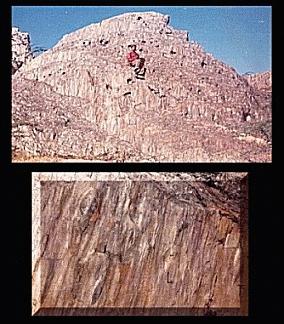
BARR CONGLOMERATE
Occuring on the western flank of the Middle Proterozoic Delhi fold belt
in Western India, this is an exceedingly deformed conglomerate, first
mapped by Heron in 1936 who described the shapes of very highly oblate
pebbles as truncheons, torpedoes, cuttle bones etc. There is a downdip
stretching lineation developed on the fabric planes which dip
subvertically to the east. The strain gradually increases from Megardha to
Giri through Barr and Biranthia for a length of 26 km. Roday and Katpatal
carried out strain determination in 1992 on detailed lines and showed that
the strai magnitude for similar shapes progressively increased from
Megardha to Barr. The pebble axes or shapes are "exreme" with X
about a metre, Y about 20 cms and Z only 2-3 cm on the average. The strain
studies revealed that the principal positive extensions swapped during the
course of progressive deformation, giving rise to two subperpendicular
lineations. The photograph is of S plane near Giri taken by Y G Katpatal.
|